|
A very fine Regency Rosewood writing box with brass
inlay Circa 1820.
Please click on images to enlarge
Reference: wb113
Description:
A very fine Regency Rosewood veneered writing box decorated on
the top and front with a continuous band of brass inlay and a
brass strip with fretted symmetrical ornament. The box opens down
to reveal a writing surface which still retains its elaborately
gold embossed leather. The box retains its original inkwells. There is a
nest of three secret drawers concealed by a sprung panel and
hidden under the pen compartments.
Origin: United Kingdom
Circa: 1820.
|
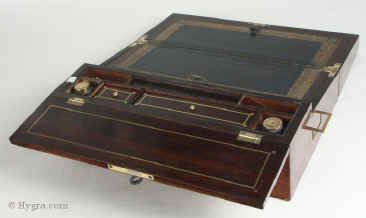
Materials: rosewood
and brass on a mahogany and pine structure.
Size: 40.5cm by 26.5 cm by 11.5 cm: 16 inches by 10.4 inches by
4.5 inches.
Condition: overall
very good. working lock and key.
|
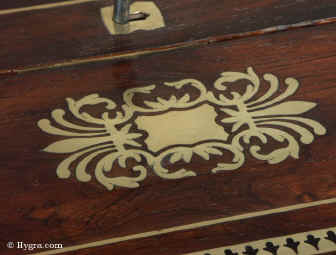
|
Detail of the central inlaid
brass motif.
|
Please click on images to enlarge
Please click on images to enlarge
The box opens down to
reveal a writing surface which still retains its elaborately gold
embossed leather. The box retains its original inkwells.
|
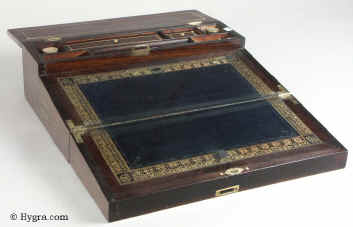
|

|
The embossed writing surface is of particularly high
quality
|
Please click on images to enlarge
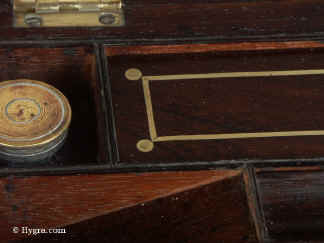
|
There is also brass accenting to the lids of the pen
compartments.
|
The box retains its original
inkwells.
|
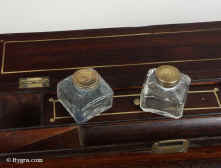
|
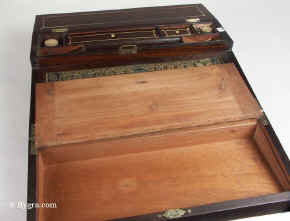
|
Some of the carcass wood such as the flaps are pine. This
was probably to reduce weight.
|
Please click on images to enlarge
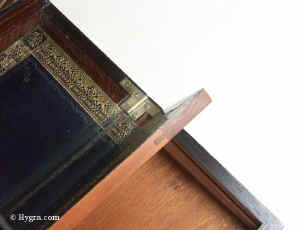
|
The flaps lift up to reveal
places for holding stationary.
|
There is a nest of three
secret drawers concealed by a sprung panel and hidden under the
pen compartments.
|

|
Please click on images to enlarge
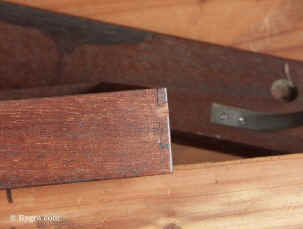
|
The secret drawers are
dovetail construction. They are made from mahogany and faced with
rosewood.
|
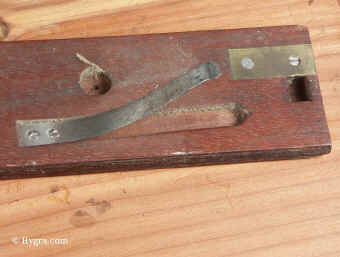
|
Detail of the sprung panel
which hides the secret drawers. The panel is released by inserting a rod
through a hole concealed by one of the inkwells.
|
Please click on images to enlarge
There is a small lift out box
with a sliding lid .
|
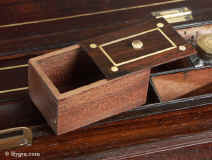
|
Please click on images to enlarge

|
The box may be carried by the
flush brass handles.
|
Please click on images to enlarge
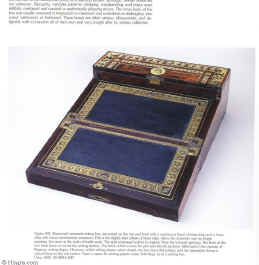
|
The box is very similar
to the box illustrated at figure 492 of
our book Antique
Boxes, Tea Caddies, and Society -- 1700--1880, ISBN:
0764316885 Antigone Clarke & Joseph O'Kelly, A
Schiffer Book for collectors.
|
News
| Buying
| email | Online
History of boxes | The
Schiffer Book |
All text and images and linked images are ©
1999-2005 Antigone Clarke and Joseph O'Kelly. If you require any further
information on permitted use, or a licence to republish any material, email us
at copyright@hygra.com
| 